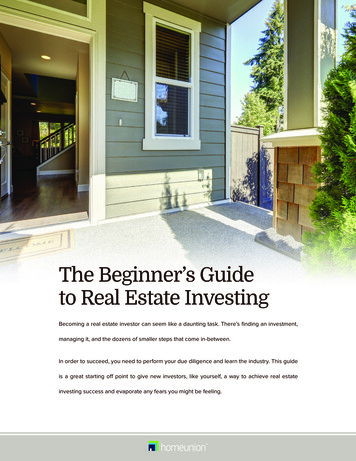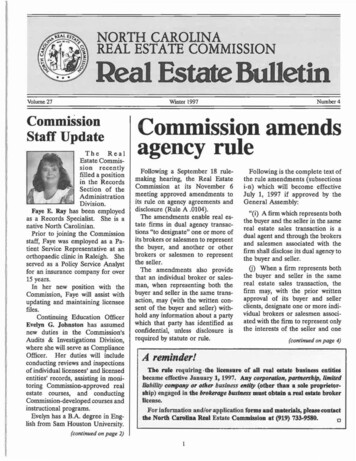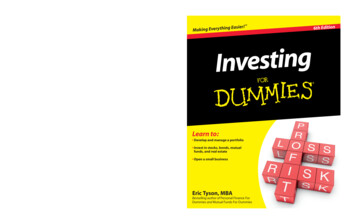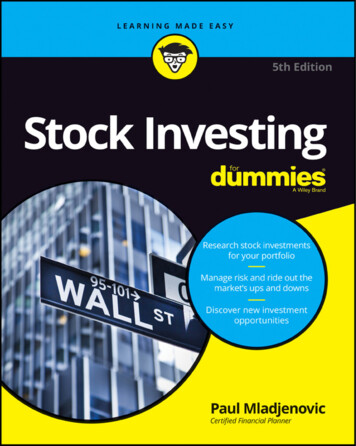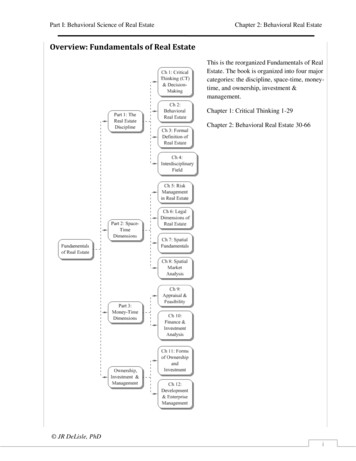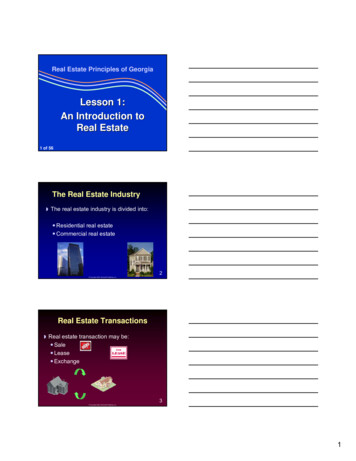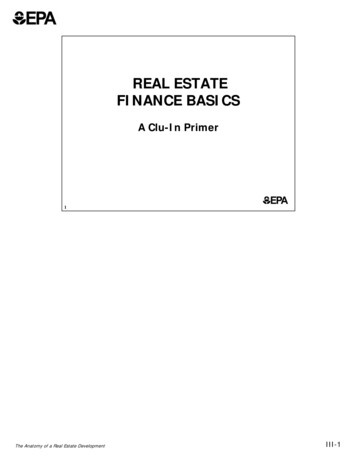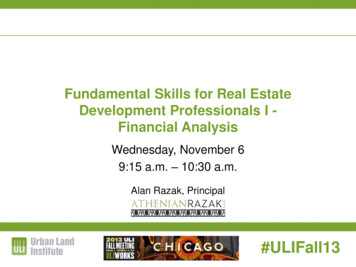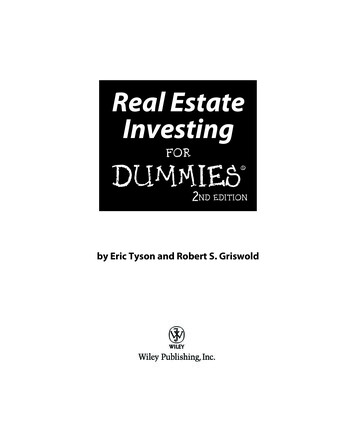
Transcription
Real EstateInvestingFORDUMmIES‰2NDEDITIONby Eric Tyson and Robert S. Griswold
Real Estate Investing For Dummies , 2nd EditionPublished byWiley Publishing, Inc.111 River St.Hoboken, NJ 07030-5774www.wiley.comCopyright 2009 Eric Tyson and Robert S. GriswoldPublished by Wiley Publishing, Inc., Indianapolis, IndianaPublished simultaneously in CanadaNo part of this publication may be reproduced, stored in a retrieval system or transmitted in any form orby any means, electronic, mechanical, photocopying, recording, scanning or otherwise, except as permitted under Sections 107 or 108 of the 1976 United States Copyright Act, without either the prior writtenpermission of the Publisher, or authorization through payment of the appropriate per-copy fee to theCopyright Clearance Center, 222 Rosewood Drive, Danvers, MA 01923, (978) 750-8400, fax (978) 646-8600.Requests to the Publisher for permission should be addressed to the Permissions Department, John Wiley& Sons, Inc., 111 River Street, Hoboken, NJ 07030, (201) 748-6011, fax (201) 748-6008, or online at http://www.wiley.com/go/permissions.Trademarks: Wiley, the Wiley Publishing logo, For Dummies, the Dummies Man logo, A Reference for theRest of Us!, The Dummies Way, Dummies Daily, The Fun and Easy Way, Dummies.com, Making EverythingEasier, and related trade dress are trademarks or registered trademarks of John Wiley & Sons, Inc. and/or its affiliates in the United States and other countries, and may not be used without written permission.All other trademarks are the property of their respective owners. Wiley Publishing, Inc., is not associatedwith any product or vendor mentioned in this book.LIMIT OF LIABILITY/DISCLAIMER OF WARRANTY: THE PUBLISHER AND THE AUTHOR MAKE NOREPRESENTATIONS OR WARRANTIES WITH RESPECT TO THE ACCURACY OR COMPLETENESS OF THECONTENTS OF THIS WORK AND SPECIFICALLY DISCLAIM ALL WARRANTIES, INCLUDING WITHOUTLIMITATION WARRANTIES OF FITNESS FOR A PARTICULAR PURPOSE. NO WARRANTY MAY BECREATED OR EXTENDED BY SALES OR PROMOTIONAL MATERIALS. THE ADVICE AND STRATEGIESCONTAINED HEREIN MAY NOT BE SUITABLE FOR EVERY SITUATION. THIS WORK IS SOLD WITH THEUNDERSTANDING THAT THE PUBLISHER IS NOT ENGAGED IN RENDERING LEGAL, ACCOUNTING, OROTHER PROFESSIONAL SERVICES. IF PROFESSIONAL ASSISTANCE IS REQUIRED, THE SERVICES OFA COMPETENT PROFESSIONAL PERSON SHOULD BE SOUGHT. NEITHER THE PUBLISHER NOR THEAUTHOR SHALL BE LIABLE FOR DAMAGES ARISING HEREFROM. THE FACT THAT AN ORGANIZATIONOR WEBSITE IS REFERRED TO IN THIS WORK AS A CITATION AND/OR A POTENTIAL SOURCE OFFURTHER INFORMATION DOES NOT MEAN THAT THE AUTHOR OR THE PUBLISHER ENDORSES THEINFORMATION THE ORGANIZATION OR WEBSITE MAY PROVIDE OR RECOMMENDATIONS IT MAYMAKE. FURTHER, READERS SHOULD BE AWARE THAT INTERNET WEBSITES LISTED IN THIS WORKMAY HAVE CHANGED OR DISAPPEARED BETWEEN WHEN THIS WORK WAS WRITTEN AND WHENIT IS READ.For general information on our other products and services, please contact our Customer CareDepartment within the U.S. at 877-762-2974, outside the U.S. at 317-572-3993, or fax 317-572-4002.For technical support, please visit www.wiley.com/techsupport.Wiley also publishes its books in a variety of electronic formats. Some content that appears in print maynot be available in electronic books.Library of Congress Control Number: 2009920906ISBN: 978-0-470-28966-2Manufactured in the United States of America10 9 8 7 6 5 4 3 2 1
Contents at a GlanceIntroduction . 1Part I: Stacking Real Estate Up AgainstOther Investments . 7Chapter 1: Evaluating Real Estate as an Investment . 9Chapter 2: Covering Common Real Estate Investments . 25Chapter 3: Considering Foreclosures, REOs, Probate Sales, and More . 43Chapter 4: Taking the Passive Approach. 61Chapter 5: Fast Money: Small Down Payments and Property Flips . 75Chapter 6: Building Your Team . 83Part II: How to Get the Money: RaisingCapital and Financing . 99Chapter 7: Sources of Capital . 101Chapter 8: Financing Your Property Purchases . 113Chapter 9: Securing the Best Mortgage Terms . 129Part III: Finding and Evaluating Properties . 137Chapter 10: Location, Location, Value . 139Chapter 11: Understanding Leases and Property Valuation . 169Chapter 12: Valuing Property through Number Crunching . 181Chapter 13: Preparing and Making an Offer . 205Chapter 14: Due Diligence, Property Inspections, and Closing . 223Part IV: Operating the Property . 259Chapter 15: Landlording 101 . 261Chapter 16: Protecting Your Investment: Insurance and Risk Management. 293Chapter 17: Recordkeeping and Accounting . 303Chapter 18: Tax Considerations and Exit Strategies . 315Part V: The Part of Tens . 339Chapter 19: Ten (Plus) Ways to Increase a Property’s Return . 341Chapter 20: Ten Steps to Real Estate Investing Success . 349Appendix: Sample Purchase Agreement . 359Index . 367
Table of ContentsIntroduction . 1How This Book Is Different . 1Foolish Assumptions . 3How This Book Is Organized . 3Part I: Stacking Real Estate Up Against Other Investments . 3Part II: How to Get the Money: Raising Capital and Financing . 4Part III: Finding and Evaluating Properties . 4Part IV: Operating the Property . 4Part V: The Part of Tens . 5Appendix . 5Icons Used in This Book . 5Where to Go from Here . 6Part I: Stacking Real Estate Up AgainstOther Investments . 7Chapter 1: Evaluating Real Estate as an Investment . . . . . . . . . . . . . . . .9Understanding Real Estate’s Income- andWealth-Producing Potential . 10Recognizing the Caveats of Real-Estate Investing . 12Comparing Real Estate to Other Investments. 13Returns . 14Risk . 15Liquidity . 15Capital requirements . 16Diversification value . 16Opportunities to add value. 16Tax advantages . 17Determining Whether You Should Invest in Real Estate . 18Do you have sufficient time? . 18Can you deal with problems? . 19Does real estate interest you? . 19Can you handle market downturns?. 19Fitting Real Estate into Your Financial Plans . 20Ensure your best personal financial health . 20Protect yourself with insurance. 20Consider retirement account funding . 21Think about asset allocation . 21
xivReal Estate Investing For Dummies, 2nd EditionChapter 2: Covering Common Real Estate Investments. . . . . . . . . . . . .25The Various Ways to Invest in Residential Income Property . 25Buying a place of your own . 26Converting your home to a rental . 26Investing and living in well-situated fixer-uppers . 28Purchasing a vacation home . 29Paying for condo hotels and timeshares . 30Surveying the Types of Residential Properties You Can Buy . 33Single-family homes . 34Attached housing . 35Apartments . 37Considering Commercial Real Estate . 38Buying Undeveloped Land . 39Chapter 3: Considering Foreclosures, REOs,Probate Sales, and More . . . . . . . . . . . . . . . . . . . . . . . . . . . . . . . . . . . . . .43Finding Foreclosures and REOs . 43Foreclosures . 45Lender REO (Real Estate Owned) . 51Getting a Jump On Foreclosure and REOCompetition with Short Sales . 52Recognizing seller benefits . 53Comparing short sales to other properties . 53Finding short-sale opportunities. 54Convincing a lender to agree to a short sale . 55Looking Into Lease Options. 57Probing Probate Sales and Auctions . 58Probate sales . 58Real estate auctions. 59Chapter 4: Taking the Passive Approach. . . . . . . . . . . . . . . . . . . . . . . . .61Using Real Estate Investment Trusts . 61Distinguishing between public and private REITs . 62Taking a look at performance. 63Investing in REIT funds . 63Tenants in Common . 65Paying for 1031 availability and “hassle free” management . 66Asking the right questions: Are TICs for you?. 67Triple Net Properties . 69Thinking ahead about landlord/tenant division of duties . 69Minimizing the risks of triple net investments. 71Notes and Trust Deeds . 71Tax Lien Certificate Sales . 72Limited Partnerships. 73
Table of ContentsChapter 5: Fast Money: Small Down Payments and Property Flips. . . . 75Purchasing with No Money Down . 75Understanding why we recommendskipping these investments . 76Finding no-money-down opportunities (if you insist). 77Buying, Fixing, and Flipping or Refinancing . 78The buy-and-flip strategy . 79The buy, fix, and refinance strategy . 81Chapter 6: Building Your Team . . . . . . . . . . . . . . . . . . . . . . . . . . . . . . . . .83Knowing When to Establish Your Team . 84Adding a Tax Advisor . 85Finding a Financial Advisor . 85Lining Up a Lender or Mortgage Broker . 87Protecting yourself by understanding lending nuances . 87Building relationships with lenders . 89Working with Real Estate Brokers and Agents . 89Seeing the value of working with an agent . 90Understanding the implications of agency:Who the agent is working for. 91Getting a feel for compensation . 92Finding a good broker or agent . 94Making the most of your agent . 96Considering an Appraiser . 96Finding an Attorney . 97Part II: How to Get the Money: RaisingCapital and Financing . 99Chapter 7: Sources of Capital. . . . . . . . . . . . . . . . . . . . . . . . . . . . . . . . . .101Calculating the Costs of Admission. 101Forgetting the myth of no money down. 102Determining what you need to get started . 103Rounding Up the Required Cash by Saving. 103Overcoming Down Payment Limitations . 105Changing your approach . 105Tapping into other common cash sources. 106Capitalizing on advanced funding strategies . 108Chapter 8: Financing Your Property Purchases . . . . . . . . . . . . . . . . . .113Taking a Look at Mortgage Options . 113Fixed-rate mortgages . 114Adjustable-rate mortgages (ARMs) . 115xv
xviReal Estate Investing For Dummies, 2nd EditionReviewing Other Common Fees . 119Making Some Mortgage Decisions . 121Choosing between fixed and adjustable . 121Selecting short-term or long-term. 123Borrowing Against Home Equity . 123Getting a Seller-Financed Loan . 124Mortgages That Should Make You Think Twice . 126Balloon loans . 126Interest-only loans . 127Recourse financing . 127Chapter 9: Securing the Best Mortgage Terms. . . . . . . . . . . . . . . . . . .129Shopping for Mortgages. 129Relying on referrals . 130Mulling over mortgage brokers. 130Web surfing for mortgages . 132Solving Potential Loan Predicaments . 134Polishing your credit report . 135Conquering insufficient income . 136Dealing with low property appraisals . 136Part III: Finding and Evaluating Properties . 137Chapter 10: Location, Location, Value . . . . . . . . . . . . . . . . . . . . . . . . . .139Deciding Where to Invest . 140Understanding the Goal: Finding PropertiesWhere You Can Add Value. 142Evaluating a Region: The Big Picture . 143Population growth . 144Job growth and income levels. 145Investigating Your Local Real Estate Market . 147Supply and demand . 148Path of progress . 153Considering barriers to entry. 154Government’s effect on real estate . 159Comparing Neighborhoods . 160Schools . 161Crime rates . 161Pride of ownership . 162Role play: What attracts you to the property?. 163Mastering Seller’s Markets and Buyer’s Markets . 165Understanding real estate cycles. 166Timing the real estate market . 167
Table of ContentsChapter 11: Understanding Leases and Property Valuation. . . . . . . .169The Importance of Evaluating a Lease . 169Reviewing a Lease: What to Look For . 171Comprehending a residential lease . 171Making sense of a commercial lease . 172Understanding the Economic Principles of Property Valuation . 173Determining highest and best use . 175Comparing fair market value and investment value . 175Reviewing the Sources of Property-Valuing Information . 176Establishing Value Benchmarks . 177Gross rent/income multiplier . 178Price per unit and square foot . 179Replacement cost . 180Chapter 12: Valuing Property through Number Crunching . . . . . . . . .181Understanding the Importance of Return on Investment . 182Figuring Net Operating Income . 183Evaluating income: Moving from fiction to useful figures . 184Tallying operating expenses. 187Calculating Cash Flow . 189Servicing debt. 190Making capital improvements . 190Surveying Lease Options that Affect Your Cost . 192Comparing some of the options . 192Accounting for common area maintenancecharges for commercial buildings . 193Visiting the Three Basic Approaches to Value . 194Market data (sales comparison) approach . 194Cost approach . 197Income capitalization approach . 198Reconciling the Three Results to Arrive at a Single Value . 201Putting It All Together: Deciding How Much to Pay. 203Examining the seller’s rental rate and expense claims . 203Deciding which set of numbers to use . 204Chapter 13: Preparing and Making an Offer . . . . . . . . . . . . . . . . . . . . .205Negotiating 101 . 205Starting with the right approach . 205Building a solid foundation of knowledge . 206Assembling attractive and realistic offers . 210Preparing to Make Your Offer: Understanding Contract Basics. 211Bilateral versus unilateral contracts . 212Elements of a contract . 212xvii
xviiiReal Estate Investing For Dummies, 2nd EditionAddressing Key Provisions in the Purchase Agreement . 215Showing intention with an earnest money deposit . 216Assigning your rights . 217Setting the closing date . 218Using contingencies effectively. 219Ironing out straggling issues . 221Presenting the Purchase Agreement. 222Chapter 14: Due Diligence, Property Inspections, and Closing. . . . .223Opening Escrow . 224Escrow instructions . 224Preliminary title report . 225Removing contingencies . 225Estimating the closing date . 226Conducting Formal Due Diligence . 227Reviewing the books and records . 227Inspecting the property . 230Negotiating Credits in Escrow . 241Determining How to Hold Title . 242Sole proprietorship . 243Joint tenancy . 243Tenancy in common . 244Partnerships . 246Limited Liability Company. 248Corporations . 250Closing the Transaction . 251Estimated closing statement . 252Title insurance . 253Property insurance . 254Final closing statement . 255Deed recording and property takeover . 257Part IV: Operating the Property . 259Chapter 15: Landlording 101 . . . . . . . . . . . . . . . . . . . . . . . . . . . . . . . . . . .261First Things First: Deciding Whether to Hire Management Help. 261Evaluating your situation and the possibilityof self-management . 262Assessing your personal skills and interests . 263Finding and Hiring Capable Professional Management . 264Doing the research . 264Talking money . 265Having the Property Tested for Environmental Concerns . 266
Table of ContentsDeciding On Rental Policies . 268Determining lease length . 268Setting the rent . 269Deciding on security deposits . 270Creating policies and guidelines . 271Working with Existing Tenants Upon Property Acquisition . 272Meeting tenants and inspecting units . 272Entering into a new rental agreement . 273Increasing rents. 274Finding Stable, Trustworthy Tenants . 275Establishing tenant selection criteria . 275Advertising for tenants . 279Showing your rental . 280Accepting applications and deposits . 283Verifying rental applications . 284Dealing with rental cosigners . 286Notifying applicants of your decision . 287Reviewing and signing documents . 288Collecting the money. 288Inspecting the property with your tenant . 289Adding Value through Renovations and Upgrades . 290Enhancing external appearances . 290Improving what’s inside . 291Using contractors .
Wiley also publishes its books in a variety of electronic formats. Some content that appears in print may not be available in electronic books. Library of Congress Control Number: 2009920906 ISBN: 978-0-470-28966-2 Manufact
